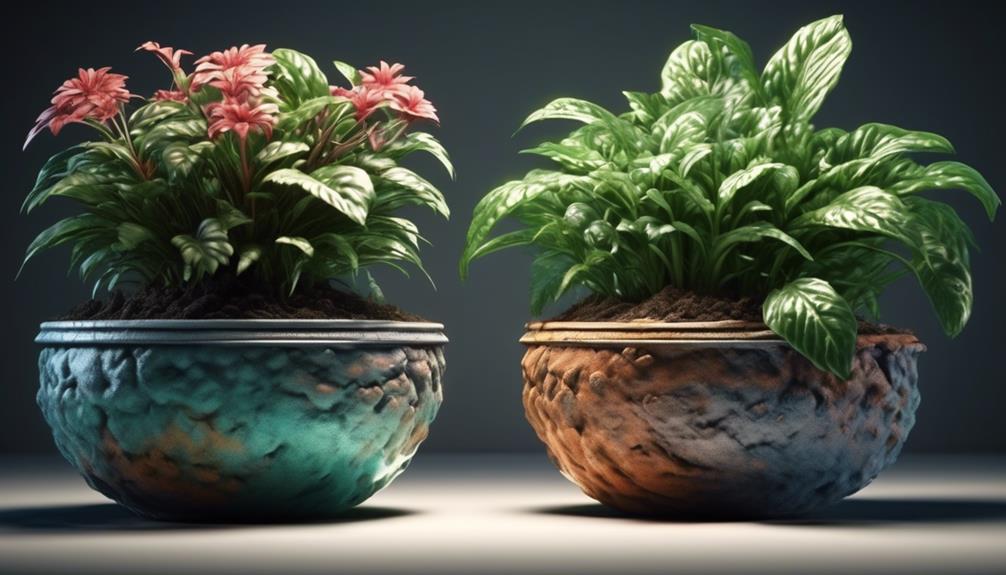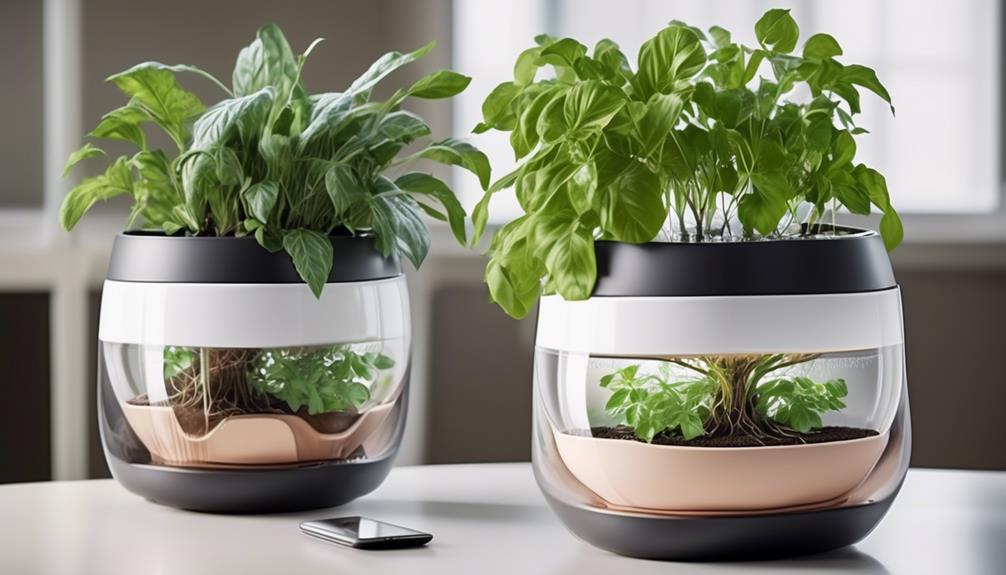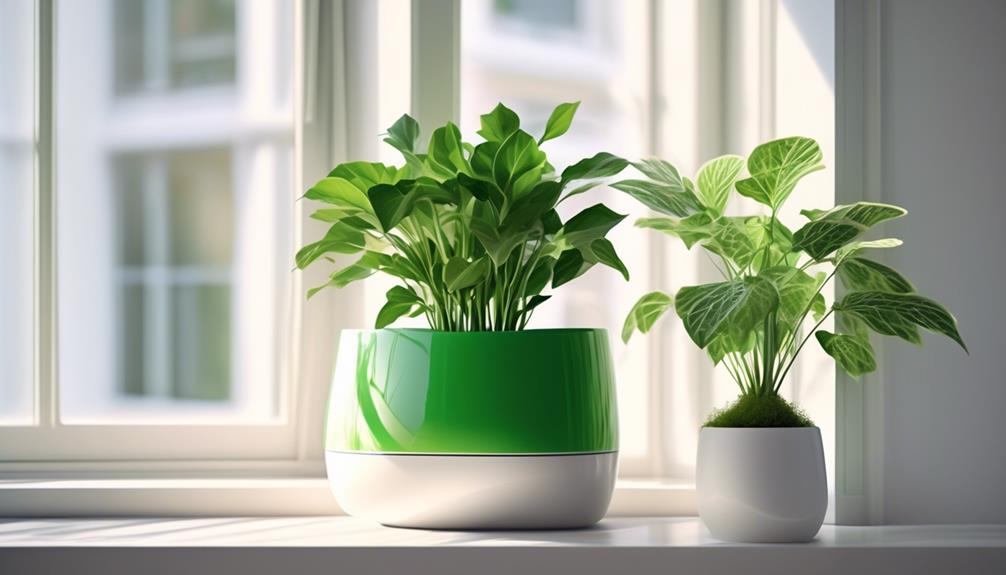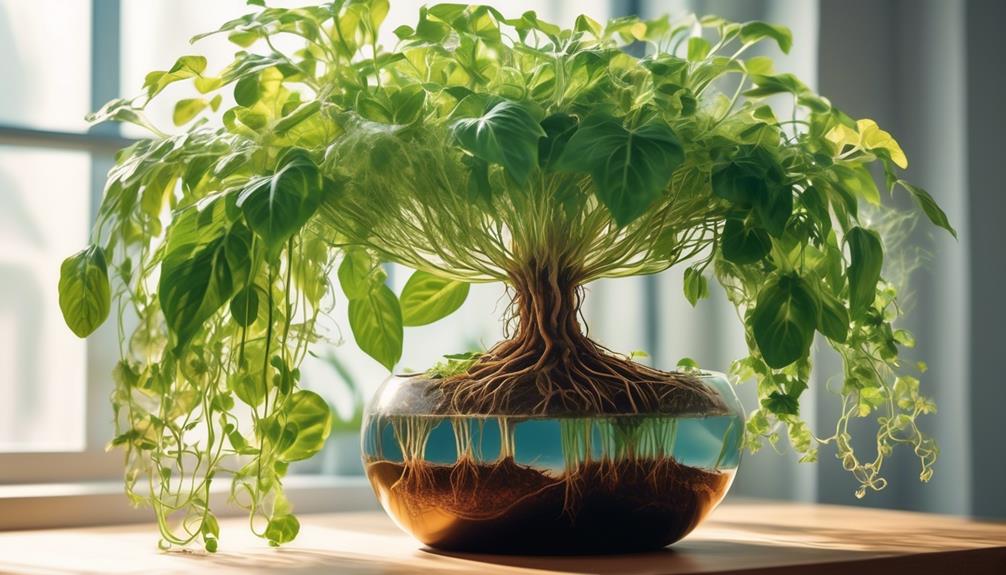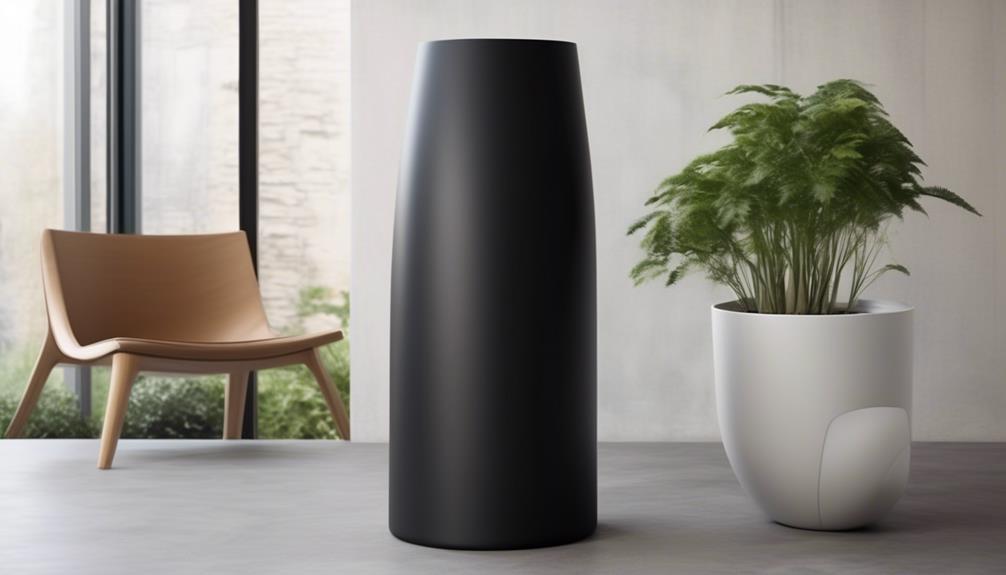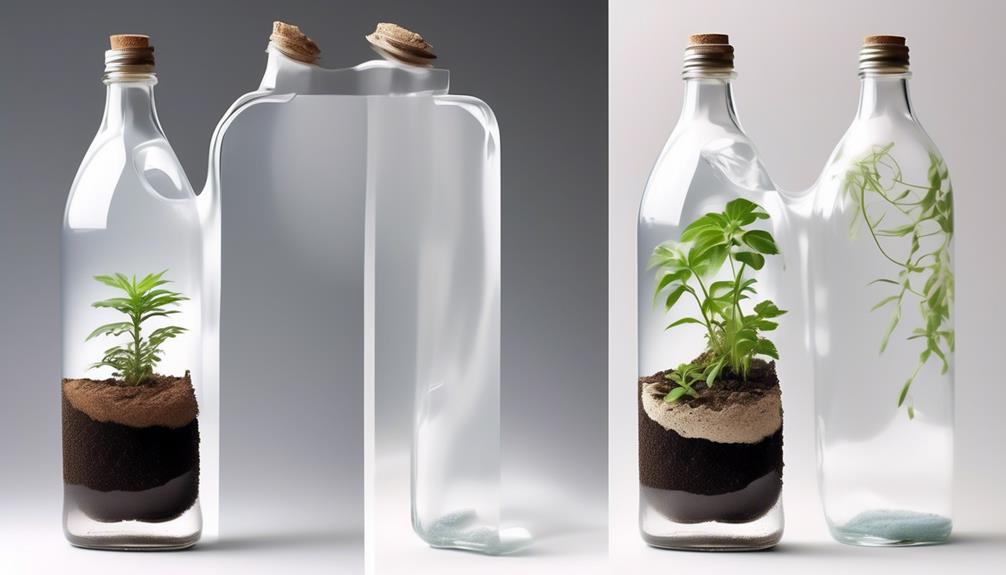At some point, we have all questioned the concept of self-watering plants. The idea that a pot could independently control its own moisture without our intervention seems almost unbelievable. However, after testing and observing these systems firsthand, it’s evident that the effectiveness of self-watering plants could surprise you.
There's a wealth of information to uncover about the science behind these systems, the benefits they offer, and the impact they can have on plant growth and health. But before we jump into all that, let's address the initial question: do self-watering plants actually work?
Key Takeaways
- Self-watering systems operate on the principle of capillary action, providing consistent moisture levels for plant roots and preventing overwatering and underwatering.
- Self-watering planters offer benefits such as optimized watering frequency, enhanced plant root health, reduced maintenance, and overall plant health and vitality.
- Different types of self-watering containers include plastic containers (lightweight and affordable), ceramic containers (excellent water retention and visually appealing), and terra cotta containers (good air circulation and natural look).
- Choosing the right soil mix is crucial for self-watering plants, with factors like organic matter, perlite or vermiculite, and a well-balanced soil mix influencing water retention, aeration, drainage, and nutrient availability.
The Science Behind Self-Watering Systems
Self-watering systems operate on the principle of capillary action to deliver water to plants as needed, ensuring consistent moisture levels and promoting healthy growth. This watering technology relies on the natural properties of water to move through small spaces, such as the soil or a wick, without the need for pumps or electricity.
The science behind self-watering systems involves understanding the principles of hydration science, specifically how water moves within a growing medium to hydrate plant roots.
Capillary action, the driving force behind self-watering systems, occurs due to the cohesive and adhesive properties of water. Water molecules are attracted to each other (cohesion) and to the material they're in contact with (adhesion), allowing water to move upwards through a wick or soil. This process ensures that the plant roots have access to water as needed, preventing both overwatering and underwatering.
Benefits of Self-Watering Planters

Understanding the science behind capillary action in self-watering systems provides insight into the numerous benefits of utilizing self-watering planters for optimal plant health and growth. Self-watering planters offer several advantages that cater to the specific needs of plants, ensuring they receive the right amount of water at the right time, promoting healthy growth and longevity.
Here are three key benefits of self-watering planters:
- Optimized Watering Frequency: Self-watering planters maintain a consistent level of moisture in the soil, preventing both overwatering and underwatering. This consistent moisture level helps to create an ideal environment for plant roots, allowing them to access water as needed without the risk of waterlogging.
- Enhanced Plant Root Health: The design of self-watering planters encourages plants to develop strong and healthy root systems. By providing a steady supply of water, the roots can grow deeply and evenly, improving their ability to absorb nutrients and support the overall health and stability of the plant.
- Reduced Maintenance: Self-watering planters reduce the frequency of manual watering, making them an excellent choice for those with busy schedules or for maintaining plants in indoor environments where regular watering can be challenging.
These benefits collectively contribute to the overall health and vitality of plants, making self-watering planters a valuable tool for plant care.
How Self-Watering Works
Self-watering planters operate through a capillary action that draws water from a reservoir into the soil as needed, ensuring consistent moisture levels for the plant. Understanding the intricate workings of this mechanism allows us to appreciate the benefits of self-watering, such as improved hydration efficiency and reduced risk of over or under-watering.
Watering Mechanism Explanation
The self-watering mechanism functions by utilizing a reservoir system to provide a consistent and controlled supply of water to the plant's roots. This design ensures that the plant receives water as needed, promoting optimal hydration and growth.
Here's how the watering mechanism works:
- Capillary Action: The self-watering pot is designed with a wicking mechanism that allows water to move from the reservoir to the soil via capillary action. This ensures that the soil remains consistently moist without becoming waterlogged.
- Water Level Indicator: Many self-watering planters are equipped with a water level indicator, allowing users to monitor the water level in the reservoir. This feature helps in preventing overwatering or underwatering, ensuring the plant receives the right amount of water.
- Aeration: Some self-watering systems incorporate aeration mechanisms to prevent water stagnation, promoting oxygen flow to the roots and preventing root rot.
These features collectively contribute to the effectiveness of self-watering planters in maintaining plant hydration and health.
Benefits of Self-Watering
Utilizing a self-watering system can significantly enhance the health and vitality of plants by providing consistent moisture levels and preventing the detrimental effects of overwatering or underwatering.
The key benefit of self-watering systems is their ability to regulate watering frequency, ensuring that plants receive the right amount of water at all times. This consistent moisture level promotes optimal plant growth by allowing the roots to access water as needed, leading to stronger and healthier plants.
Additionally, self-watering systems reduce the risk of water stress, which can lead to stunted growth and decreased fruit or flower production. By maintaining a balanced water supply, self-watering systems create an ideal environment for plants to thrive, ultimately resulting in lusher foliage, vibrant blooms, and higher yields.
Plant Hydration Efficiency
Achieving optimal plant hydration efficiency through a self-watering system involves the precise regulation of moisture levels to support healthy root development and overall plant growth.
When considering plant hydration, it's essential to understand the mechanisms at play.
1) The self-watering system utilizes a reservoir to store water, which is gradually released to the plant's root zone, ensuring a consistent supply of moisture.
2) The system incorporates a wicking mechanism that allows the soil to draw up water as needed, preventing over-saturation.
3) Additionally, some self-watering systems are equipped with moisture sensors to monitor soil moisture levels, providing real-time data for precise watering control.
Understanding soil moisture dynamics and its impact on plant hydration is crucial for the successful implementation of self-watering systems.
Types of Self-Watering Containers
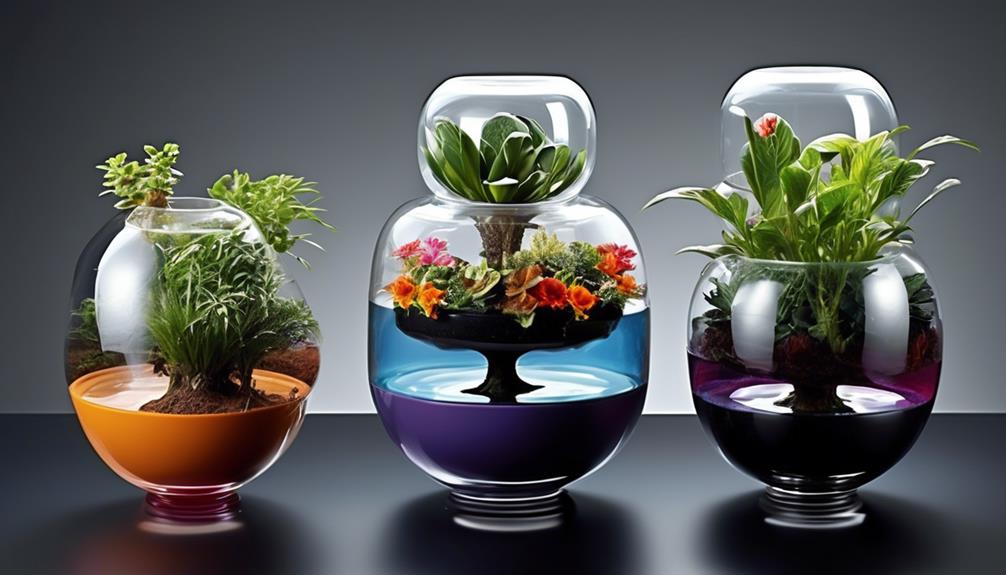
Exploring various materials and designs for self-watering containers can provide insight into their effectiveness and suitability for different plant types. When considering self-watering container options, it's important to understand the specific needs of the plants you intend to grow. Some self-watering containers are made of plastic, while others are crafted from ceramic or terra cotta. Each material has its own benefits and drawbacks, affecting factors such as moisture retention, durability, and aesthetic appeal. Additionally, the design of the self-watering container, including the size and placement of the water reservoir, can impact its functionality.
| Material | Pros | Cons |
|---|---|---|
| Plastic | Lightweight, durable, affordable | May degrade over time, less aesthetically pleasing |
| Ceramic | Excellent water retention, visually appealing | Heavier, more fragile, may be expensive |
| Terra Cotta | Good air circulation, natural look | Porous, may require more frequent watering, prone to cracking |
When it comes to self-watering container maintenance, understanding the specific requirements of the container material is crucial. Plastic containers are easy to clean and maintain, while ceramic and terra cotta containers may require more delicate handling to prevent damage. Regular inspection of the water reservoir and drainage system is also essential to ensure optimal functionality.
Choosing the Right Soil Mix
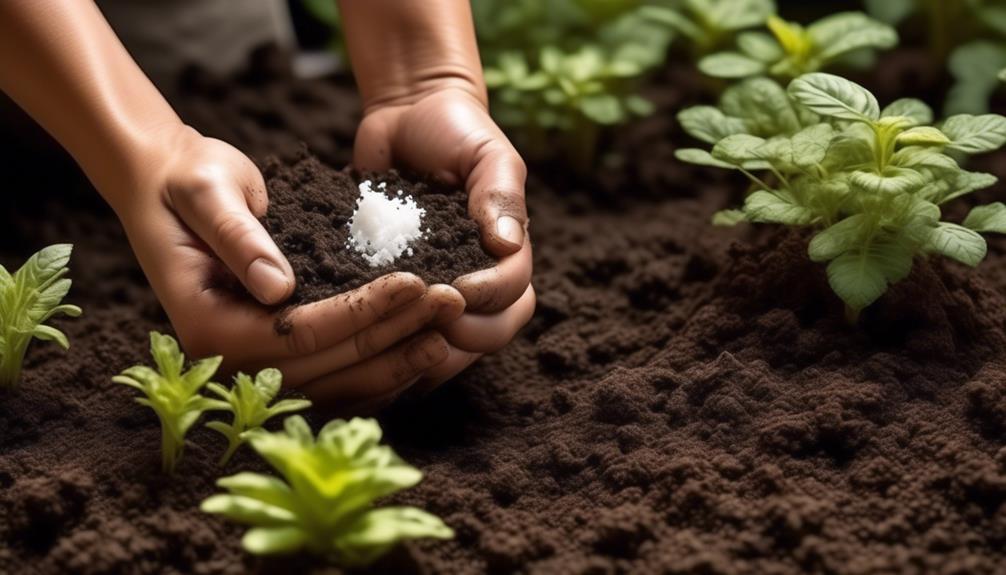
When choosing the right soil mix for self-watering plants, it's crucial to consider soil moisture retention, nutrient availability, and aeration and drainage.
These factors play a significant role in the overall health and growth of your plants.
Soil Moisture Retention
Choosing the right soil mix is crucial for maximizing soil moisture retention in self-watering plants. When it comes to soil moisture retention, the following factors play a crucial role:
- Organic Matter: Incorporating organic matter such as compost or peat moss into the soil mix helps improve its water retention capacity by increasing its ability to hold onto moisture.
- Perlite or Vermiculite: Adding perlite or vermiculite to the soil mix can improve aeration and drainage, preventing waterlogging while ensuring the soil retains adequate moisture.
- Coconut Coir: Utilizing coconut coir in the soil mix can enhance its water retention properties, as it has a high water holding capacity and provides a slow-release water source for the plants.
Nutrient Availability
To optimize nutrient availability in self-watering plants, the selection of a well-balanced soil mix is essential for promoting healthy growth and development. The soil mix directly impacts the plant's ability to absorb essential nutrients and supports robust root development. A balanced soil mix should provide adequate aeration, moisture retention, and nutrient availability. Here's an example of a well-balanced soil mix:
| Component | Function |
|---|---|
| Peat Moss | Retains moisture |
| Perlite | Improves aeration |
| Compost | Provides nutrients |
| Vermiculite | Aids nutrient absorption |
The peat moss retains moisture, while perlite enhances aeration, creating an ideal environment for root development. Compost and vermiculite contribute to nutrient absorption, ensuring that the plants have access to essential elements for healthy growth.
Aeration and Drainage
Optimizing nutrient availability in self-watering plants through a well-balanced soil mix is crucial for promoting healthy growth and development, particularly in creating an ideal environment for aeration and drainage.
When considering aeration benefits and drainage solutions in the soil mix for self-watering plants, it's essential to:
- Incorporate perlite or vermiculite to improve aeration and drainage by enhancing soil porosity and reducing compaction.
- Utilize organic matter such as compost to aid in moisture retention while still allowing for adequate drainage, promoting a healthy balance.
- Consider adding coarse sand to the soil mix to further facilitate drainage and prevent waterlogging, ensuring optimal oxygen levels for the plant roots.
Understanding Plant Watering Needs
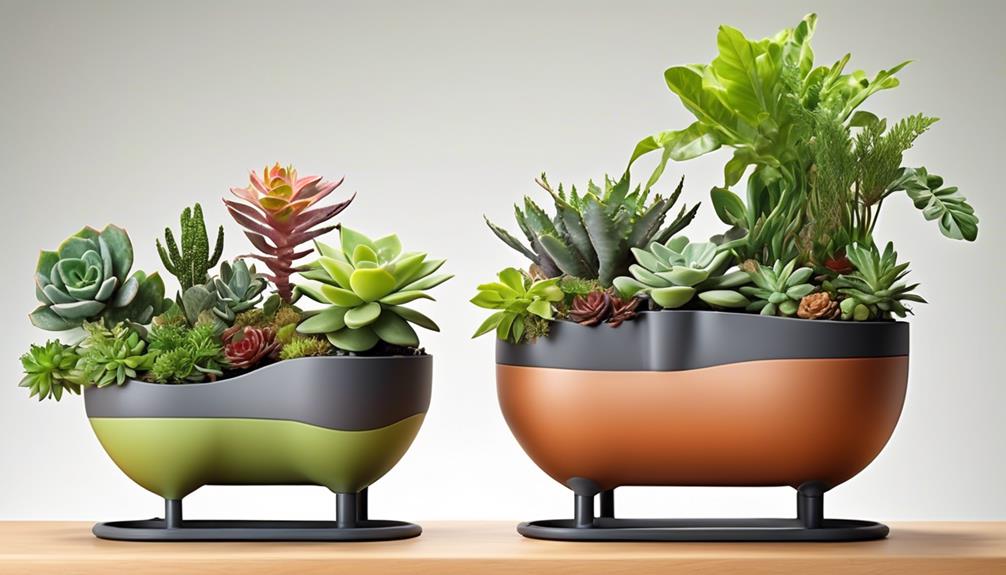
Understanding the specific water requirements of different plant species is crucial for maintaining their health and promoting optimal growth. Watering frequency and plant-specific needs are key factors to consider when determining the watering needs of plants.
It's essential to recognize that different plant species have varying requirements for moisture levels in their soil. Factors such as the type of soil, climate, and the stage of growth also influence the watering needs of plants. For instance, succulents generally require less frequent watering due to their ability to store water, while tropical plants may need more consistent moisture.
Understanding the specific water requirements of plants involves considering the plant's native environment, the season, and the individual plant's characteristics. Through careful observation and understanding of the plant's behavior, one can adjust the watering frequency and amount to meet the plant's specific needs. This knowledge allows for a more tailored approach to plant care, ensuring that they receive the appropriate amount of water, thereby promoting healthy growth and vitality.
Maintaining Proper Moisture Levels
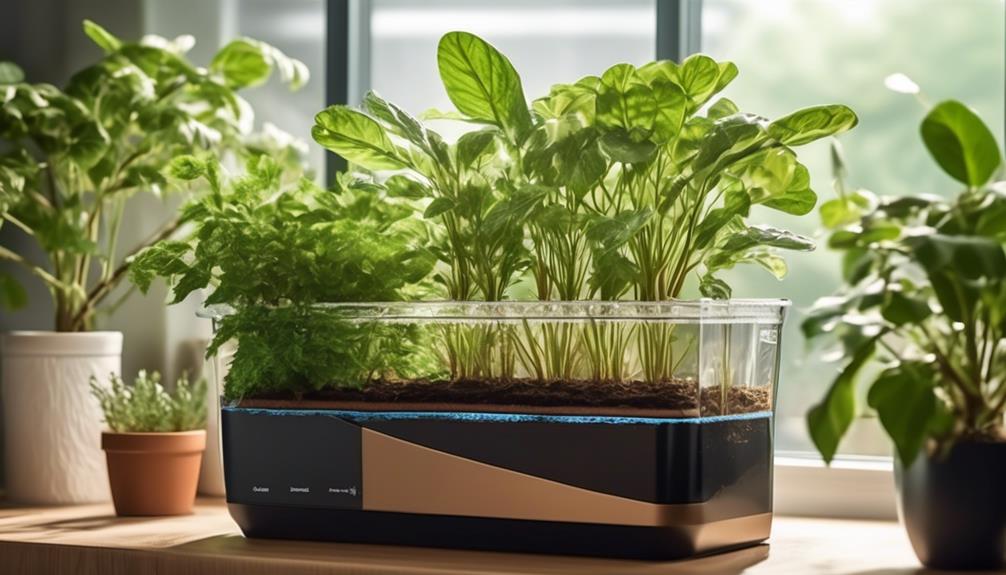
As we examine the efficiency of self-watering systems, it's crucial to understand the importance of maintaining proper moisture levels in plants.
We'll explore how these systems can prevent overwatering, which is a common issue that can lead to root rot and other plant health problems.
Additionally, we'll delve into the intricacies of maintaining optimal moisture levels to ensure the overall well-being of the plants.
Watering System Efficiency
Maintaining proper moisture levels in self-watering plants is essential for ensuring the efficient operation of the watering system. To achieve this, we need to consider the following:
- Watering Frequency and Efficiency: It's crucial to strike a balance between providing enough water to the plant and preventing overwatering. By adjusting the watering frequency based on plant type, size, and environmental conditions, we can optimize the system's efficiency.
- Evaporation and Soil Moisture: Understanding the rate of evaporation in the specific environment where the self-watering plant is located is key. Additionally, monitoring the soil moisture level is essential to ensure that the plant receives adequate hydration without leading to water wastage or potential root rot.
- Proper Water Distribution: Ensuring that the watering system effectively distributes water throughout the soil, reaching the plant's roots, is fundamental for maintaining optimal moisture levels.
Preventing Overwatering
Considering the importance of maintaining proper moisture levels in self-watering plants, it is vital to focus on preventing overwatering to optimize the efficiency of the watering system. Preventing underwatering is equally crucial to ensure the health of the plants. By employing moisture control techniques, we can strike a balance to maintain optimal moisture levels. Here are some effective moisture control techniques for preventing overwatering:
| Technique | Description | Benefits |
|---|---|---|
| Monitoring Soil Moisture | Use a soil moisture meter to gauge the actual moisture level and avoid overwatering. | Prevents soil waterlogging and root rot. |
| Proper Drainage | Ensure that the self-watering planters have adequate drainage holes to prevent water accumulation. | Prevents waterlogging and promotes aeration. |
| Adjusting Watering Schedule | Adjust the watering frequency based on the plant's needs and environmental conditions. | Prevents overhydration and root suffocation. |
| Using Well-Draining Soil | Choose a well-draining potting mix that allows excess water to drain easily, preventing water accumulation. | Prevents water retention and root rot. |
Potential Drawbacks of Self-Watering
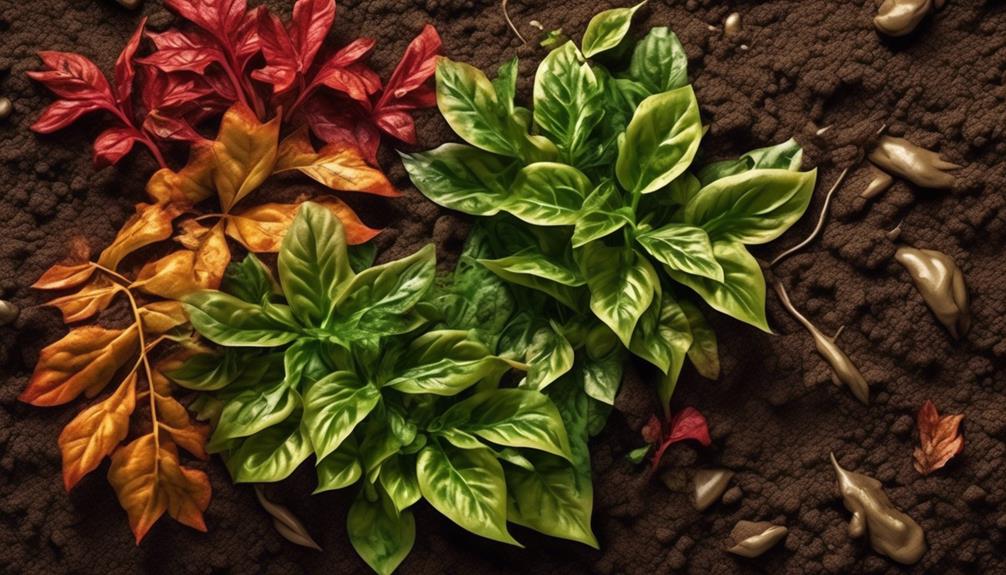
While self-watering systems can be effective in providing consistent moisture to plants, they may also lead to overwatering if not properly monitored. Here are some potential drawbacks and maintenance challenges to consider:
- Watering frequency: Self-watering systems rely on a reservoir of water that gradually seeps into the soil. However, in some cases, this can lead to a constant supply of water, which may not align with the plant's actual needs. This can result in overwatering, leading to root rot and other water-related issues.
- Root health: Over time, self-watering systems can create a dependency for plants, causing their roots to stay near the surface where the water is abundant. This can hinder the development of deep and robust root systems, making the plants less resilient to environmental stressors.
- Maintenance challenges: While self-watering systems are designed to reduce the frequency of watering, they still require regular monitoring and maintenance. The reservoir needs to be refilled, and the system should be checked to ensure it's functioning correctly. Neglecting this maintenance can lead to under or overwatering, which can impact plant health.
Understanding these potential drawbacks and being attentive to the maintenance needs of self-watering systems is crucial for ensuring the overall health and vitality of your plants.
Tips for Successful Self-Watering
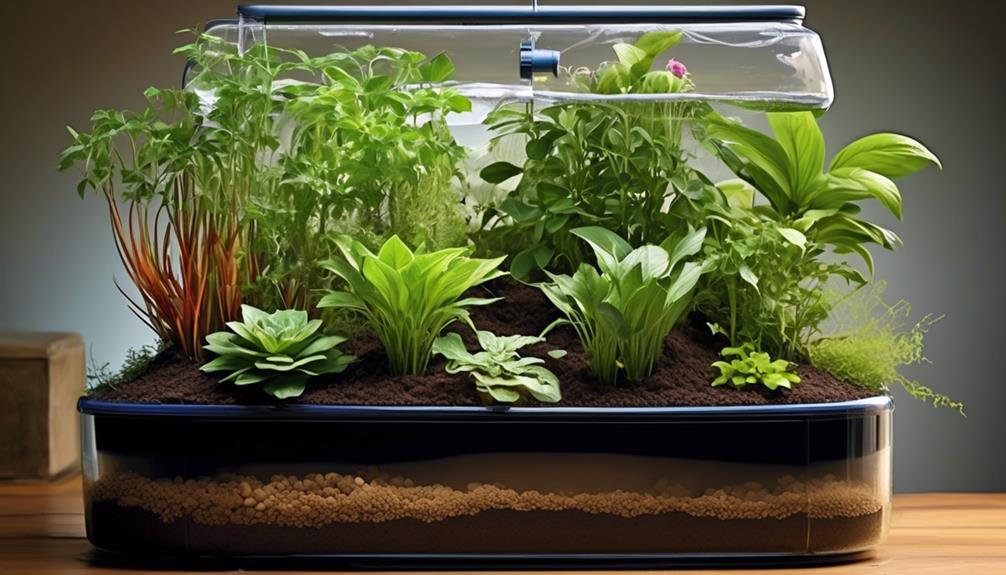
To ensure successful self-watering for your plants, it's essential to understand and implement effective strategies. These strategies address the potential drawbacks of overwatering and maintenance challenges associated with self-watering systems.
First and foremost, mastering the watering frequency is crucial. Different plants have varied water requirements, so it's important to understand the specific needs of each plant in your self-watering containers. Monitor the moisture levels regularly to ensure that your plants are receiving the appropriate amount of water.
Container size also plays a critical role in successful self-watering. The size of the container should be proportional to the size and water needs of the plant. Larger containers generally require less frequent watering as they can hold more water, while smaller containers may need more frequent refills.
Additionally, consider the root system of the plant when choosing the container size. A well-sized container will ensure that the plant has enough space for healthy root growth and that the self-watering system can adequately supply water to the entire root zone.
Common Self-Watering Mistakes
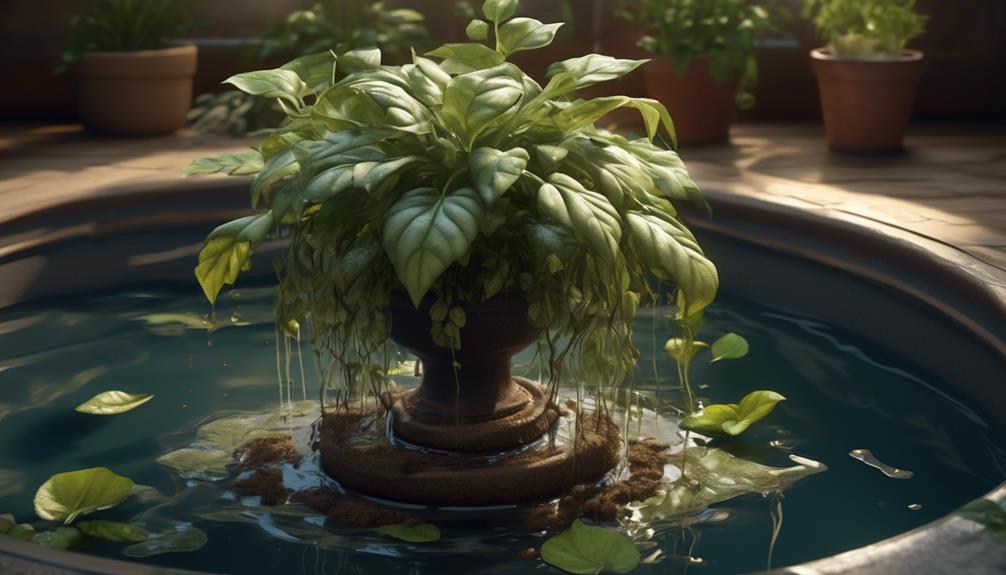
In our experience, one of the most common self-watering mistakes is neglecting to regularly check the moisture levels in the soil of the plants. Monitoring the soil moisture is crucial for the proper functioning of self-watering systems.
Here are three common watering mistakes and tips for troubleshooting self-watering systems:
- Overlooking the Water Level Indicator: Many self-watering pots come with water level indicators, but they're often overlooked. It's important to regularly check these indicators to ensure that the water reservoir is adequately filled. If the water level is low, the plant may not receive sufficient water, leading to dry soil and potential wilting.
- Ignoring Drainage Issues: Improper drainage can lead to waterlogging, which can be detrimental to plant health. Check for clogged drainage holes or a malfunctioning wicking system. Ensure that excess water can escape from the soil, allowing air to reach the roots.
- Inconsistent Watering: Some gardeners make the mistake of assuming that self-watering systems eliminate the need for any manual watering. However, factors such as temperature, humidity, and plant size can affect water uptake. It's important to adjust the watering schedule based on these factors to prevent under or overwatering.
Comparing Self-Watering Vs. Traditional Watering
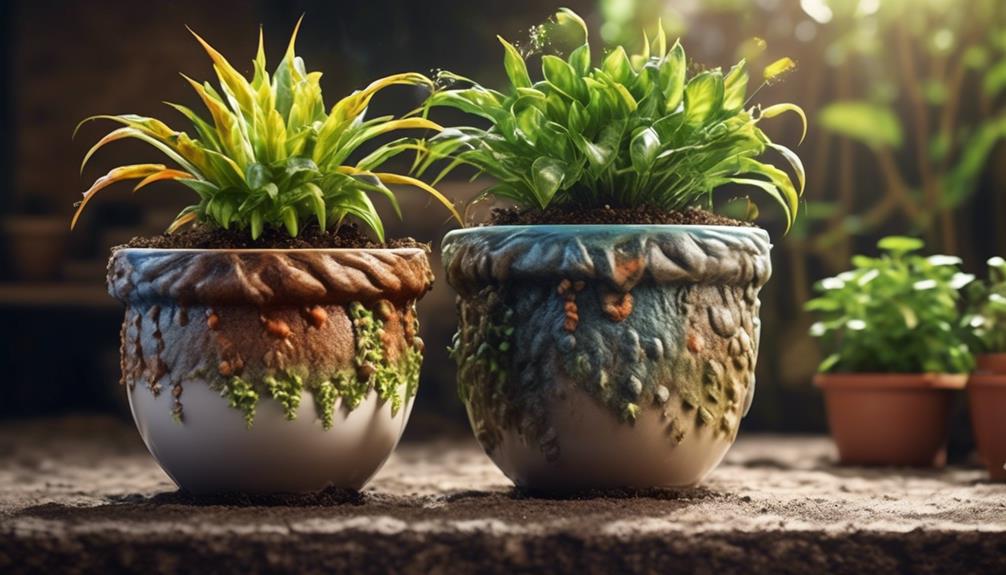
Regularly assessing the effectiveness of self-watering systems in comparison to traditional watering methods is essential for understanding their practical implications in plant care. Traditional watering involves manual techniques such as watering cans, hoses, or irrigation systems, requiring consistent monitoring and adjustment based on plant needs and environmental conditions. In contrast, self-watering systems use automated technology to provide water to plants as needed, reducing the reliance on manual intervention.
When comparing traditional vs. automated watering, it's important to consider factors such as water efficiency, consistency of moisture levels, and labor requirements. Self-watering systems can offer benefits such as reduced water wastage, as they deliver water directly to the plant roots, minimizing evaporation. Additionally, these systems provide a more consistent moisture level, which is crucial for optimal plant growth. However, traditional watering methods allow for more precise control over the amount and location of water application, which can be beneficial for certain plant species or specific gardening techniques.
Understanding the strengths and limitations of each approach is vital for selecting the most suitable watering method based on individual plant requirements and the grower's preferences. By critically evaluating traditional and self-watering methods, gardeners can make informed decisions to optimize plant health and overall water management.
Impact on Plant Growth and Health
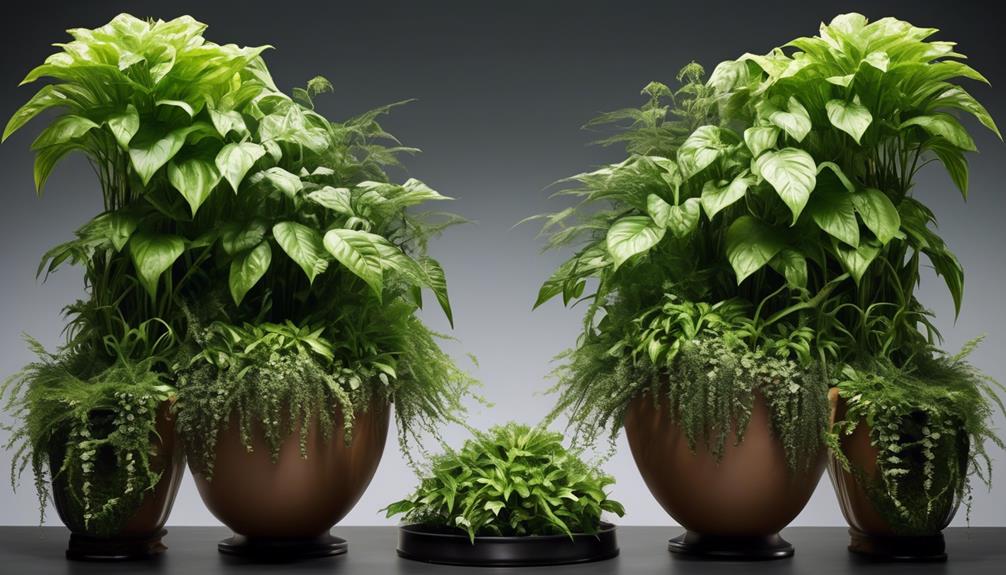
Assessing the impact of self-watering systems on plant growth and health requires a thorough understanding of their mechanisms and the specific needs of the plant species involved. The following key points shed light on the impact of self-watering systems:
- Growth Impact: Self-watering systems provide a consistent moisture level, promoting steady growth and development. By ensuring that plants receive water as needed, these systems prevent under or overwatering, which can both stunt growth. The controlled hydration also encourages root development, leading to healthier and more robust plants.
- Health Benefits: With a self-watering technique, plants are less prone to stress from inconsistent watering, leading to overall improved health. Reduced stress allows plants to allocate more energy towards growth, flowering, and fruiting. Additionally, the controlled environment created by self-watering systems can deter pests and diseases, further enhancing plant health.
- Watering Technique and Plant Development: Self-watering systems support optimal plant development by maintaining a balanced water supply. This allows for efficient nutrient uptake, which is crucial for robust growth and overall plant well-being.
DIY Self-Watering Solutions
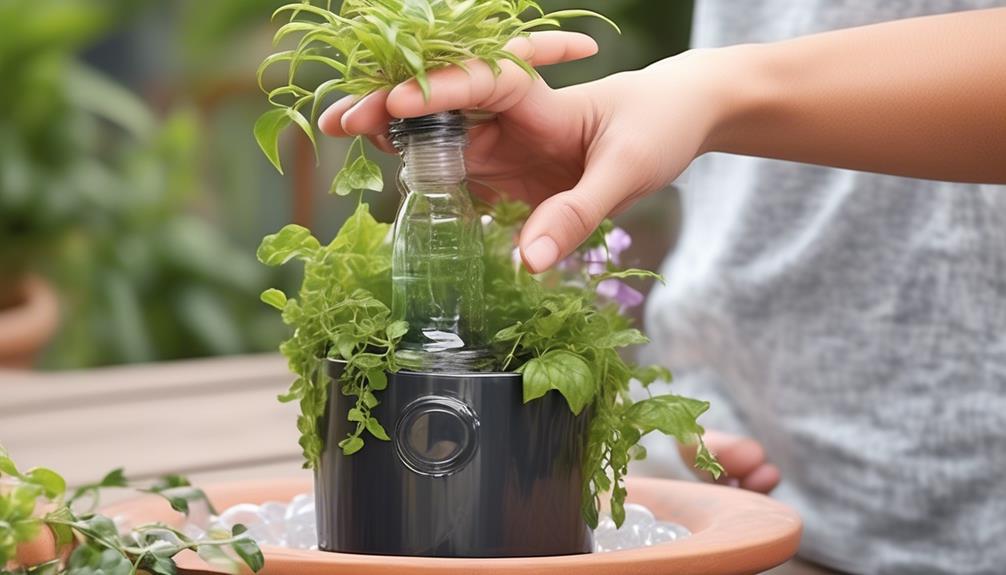
Let's explore a practical and effective method for creating DIY self-watering solutions to ensure consistent hydration for your plants.
When considering self-watering planter options, there are several DIY watering solutions that can be easily implemented. One popular method involves using a wicking system, where a wick, such as a piece of cotton or nylon rope, is placed in the soil and submerged in a water reservoir. The wick draws water up into the soil, providing a steady supply of moisture to the plant's roots.
Additionally, creating a simple self-watering planter using plastic containers or bottles can be an affordable and efficient solution. By drilling a hole in the lid of the container and inserting a wick through it into the soil, the container can act as a water reservoir, ensuring the plant receives water as needed.
Another DIY approach involves repurposing old wine bottles as self-watering devices by filling them with water and inserting them upside down into the soil near the plant.
These DIY self-watering solutions offer practical and sustainable ways to maintain optimal moisture levels for your plants.
Environmental Considerations
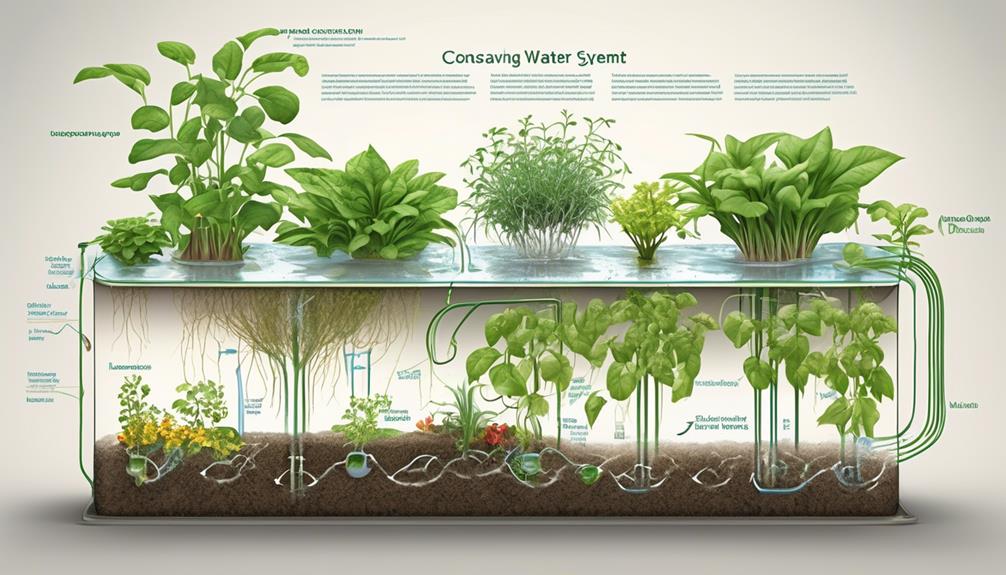
Considering the environmental impact of self-watering solutions is crucial in ensuring sustainable and responsible plant care practices. When evaluating the environmental considerations of self-watering systems, several key factors come into play:
- Sustainable Practices and Water Conservation: Self-watering planters can contribute to sustainable practices by conserving water. These systems often use a reservoir to store water, which minimizes wastage through evaporation and runoff. By providing plants with a consistent and controlled water supply, these solutions promote efficient water usage, supporting sustainable gardening practices.
- Environmental Impact and Resource Usage: It's essential to assess the overall environmental impact of self-watering solutions, including the materials used in their construction and their energy requirements. Evaluating resource usage, such as the production and transportation of materials, can shed light on the environmental footprint of these systems. Understanding these aspects can help individuals make informed decisions about the environmental implications of utilizing self-watering planters.
- Long-Term Benefits for Ecosystems: By implementing self-watering solutions, individuals can contribute to maintaining healthier ecosystems. Conserving water and reducing resource consumption not only benefit the immediate surroundings but also have broader positive impacts on the environment.
Carefully considering these environmental aspects is pivotal in making informed choices and adopting sustainable practices for plant care.
Real-World Experiences With Self-Watering
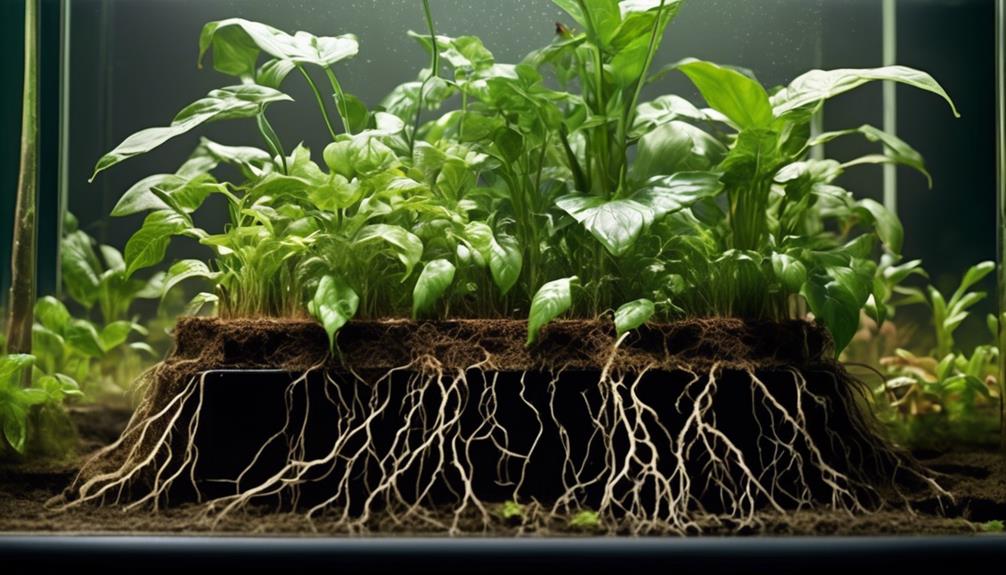
When evaluating the real-world experiences with self-watering systems, we observe their impact on plant health and growth in various environmental conditions. In real-life experiences, user testimonials have provided valuable insights into the effectiveness of self-watering systems. Here is a summary of some of the experiences shared by users:
| Experience | Impact on Plant Health | Impact on Growth | Environmental Conditions |
|---|---|---|---|
| User 1 | Improved | Significant | Indoor |
| User 2 | Consistent | Moderate | Outdoor |
| User 3 | Maintained | Substantial | Tropical |
| User 4 | Enhanced | Minimal | Arid |
These testimonials highlight the diverse impact of self-watering systems on plant health and growth. Users reported improvements in plant health, significant growth, and consistent maintenance across different environmental conditions. These real-life experiences emphasize the practical benefits of self-watering systems and provide valuable insights for individuals considering implementing such systems for their plants.
Frequently Asked Questions
Are Self-Watering Plants Suitable for All Types of Plants, or Are There Certain Species That Do Not Thrive in This Type of System?
Certain plant species may not thrive in self-watering systems due to their specific water requirements. While self-watering planters offer benefits such as consistent moisture and reduced maintenance, drawbacks include the potential for overwatering and limited control over soil moisture.
Best plants for these systems are those that prefer consistently moist soil, like ferns and peace lilies. However, succulents and cacti, which prefer drier conditions, may not do well in self-watering planters.
Can Self-Watering Planters Be Used Outdoors, and if So, How Do They Perform in Different Weather Conditions?
Outdoors, self-watering planters perform differently depending on weather conditions. Different plant species have varying compatibility with this system. Maintenance requirements are generally lower, and water consumption is efficient.
However, potential concerns include overwatering and potential root rot. Understanding the specific needs of the plant species and monitoring the planter's moisture levels are key to successful outdoor performance in various weather conditions.
Are There Any Specific Maintenance Requirements for Self-Watering Containers, Such as Cleaning or Replacing Parts Over Time?
Maintenance tips for self-watering containers include:
- Regularly cleaning the system to prevent clogs and algae buildup.
- Checking for replacement parts, such as the wick or water reservoir, that may be needed over time.
Establishing a cleaning schedule and monitoring the container's lifespan ensures optimal performance.
How Do Self-Watering Systems Impact the Water Consumption of Plants Compared to Traditional Watering Methods?
When using self-watering systems, we notice a significant impact on watering frequency and soil moisture.
These systems provide a consistent water supply, promoting optimal soil moisture levels and reducing the need for frequent manual watering.
As a result, plant growth and nutrient absorption are enhanced, leading to healthier and more vibrant plants.
This efficient water delivery method minimizes water wastage and ensures that plants receive the right amount of hydration, contributing to sustainable and thriving plant growth.
Are There Any Potential Risks or Concerns Associated With Using Self-Watering Planters, Such as Mold Growth or Root Rot?
Potential risks associated with self-watering planters include mold growth and root rot. These concerns depend on the suitability of the planter for specific plant species, outdoor use, and weather conditions. Regular maintenance is crucial to prevent these issues.
Compared to traditional watering methods, self-watering planters can affect water consumption. Understanding the maintenance requirements and selecting the right planter for your plants is essential to mitigate these risks.
Are Self Watering Planters Effective in Keeping Plants Hydrated?
Yes, self watering planters are worth the investment for keeping plants hydrated. These innovative planters have built-in reservoirs that provide a consistent water supply to the plants, reducing the need for frequent watering. This makes them an effective solution for maintaining optimal hydration levels for your plants.
Conclusion
In conclusion, self-watering plant systems work like a well-oiled machine, providing consistent moisture to plant roots without the need for constant monitoring.
They function like a reliable friend, always there to take care of your plants in your absence.
With the right setup and maintenance, self-watering systems can be a game-changer for both novice and experienced gardeners, ensuring healthy, thriving plants with minimal effort.

